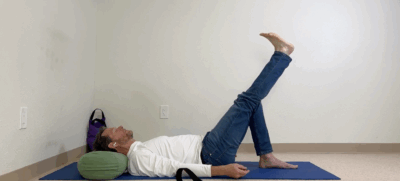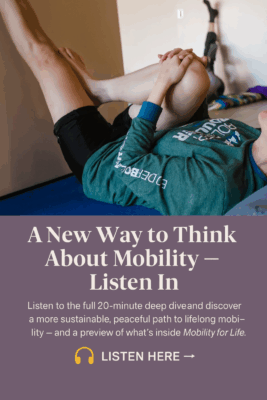 Yoga for vertigo can be a natural and effective way to manage dizziness by improving balance, releasing tension, and promoting relaxation. Many people experience vertigo due to stress, misalignment, or underlying conditions, and yoga can help resolve these issues gently over time.
Yoga for vertigo can be a natural and effective way to manage dizziness by improving balance, releasing tension, and promoting relaxation. Many people experience vertigo due to stress, misalignment, or underlying conditions, and yoga can help resolve these issues gently over time.
Avita Yoga is a practice primarily designed for bone and joint health. Over the years, I’ve had students come into practice who experience vertigo. Some shape or movement we do triggers an episode, and then I learn that vertigo is something they deal with in their life.
If there is a movement that triggers pain or vertigo, we avoid it. However, our lives can become narrower and narrower when we avoid movements because of pain. Restrictions and compensations accumulate in the body, contributing to other issues. We need a way to unwind the pain and patterning that contribute to vertigo. In this article, we will explore Avita Yoga for vertigo and share some movements to help resolve it. But first, let’s look at some common causes.
Causes of Vertigo
Crystals in the Inner Ear: Sometimes, tiny calcium deposits in the inner ear can throw off your balance. When they shift, it can trigger episodes of dizziness or vertigo.
Neurological Issues: Conditions like migraines or strokes can affect the brain or nervous system, causing dizziness and vertigo due to disrupted communication within the body.
Over-closed Bite: When the teeth or jaw are misaligned, it can create tension in the neck, shoulders, and head, leading to dizziness or vertigo.
Stressors: High stress and anxiety can cause tension to build up, particularly in the neck and shoulders, which can trigger vertigo or worsen existing symptoms.
If we rule out these issues, what I have found is that some degree of stress or tension in the upper back, shoulders, or neck often impacts the nervous system. This, in turn, affects the vestibular system and our ability to balance, creating a sensation of dizziness. If we succumb to the pain and limitations—if we fear movements that trigger these episodes—our lives become narrower, we stop having fun, and we avoid certain movements, which can lead to further restrictions. My goal here is to show you simple movements to regain your life and carefully reintroduce these movements without triggering vertigo.
That means it is best to practice these movements when you are not having an episode. The goal is to unwind tension and restrictions slowly and carefully, without triggering headaches or migraines, and ultimately return to a regular practice. You may even be inspired to develop a consistent practice to maintain freedom of movement throughout your body—it’s all connected.
One important piece of yoga equipment I recommend is a 3-inch foam block. They come in 4-inch and 3-inch versions, but I suggest the 3-inch one.
Step one
How to Practice:
- Lie on your back with your head supported on the foam block.
If you don’t have a foam block, you can substitute a folded blanket—use a dense cotton or wool blanket folded to about 2 or 3 inches. However, investing in a foam block will be beneficial.
- Begin by lying on your back, knees bent, feet on the floor, and head supported by the foam block.
- Arms at the sides.
I typically encourage students to practice with their eyes closed, but if you are experiencing vertigo or are susceptible to it, please keep your eyes open and focus on a spot on the ceiling.
- Let your arms rest and relax—this is step one. Head supported, shoulders relaxing, perhaps closing your eyes and relaxing your jaw.
Maintain a feeling of safety throughout the movement. Ask yourself: Does it feel safe? Do you feel secure and grounded? If keeping your eyes open helps, then keep them open.
- Slowly start to turn your head to one side—left or right—rolling your head on the block, chin moving toward the shoulder.
This slow, thoughtful movement allows you to observe feedback or sensations. Do you feel pain? Arthritis? A potential vertigo episode coming on?
- Assess the feedback and allow your system to adapt. Spend time with restrictions.
If you experience discomfort, stop, relax, slow down, and allow your body to reorganize and adapt. Move just a few degrees, relax, and wait before considering moving further.
- After one to two minutes, slowly bring your head back to the center and pause.
We are reclaiming movement and getting our life back here.
- Slowly test the other side, rolling the head to the opposite side.
- If you feel tension, stress, or strain, you have found the restriction. Spend time with it. You can celebrate finding it because now you can resolve it.
- After one to two minutes, bring your head back to the center.
You can set a timer, but it’s not necessary. Let it be intuitive and trust your inner guidance.
Step Two
How to Practice:
- Move the arms toward a T-shape. If you feel any restriction or limitation along the way, stop. You don’t know if the restriction in your shoulder is contributing to the issue.
Our bodies have the ability to dissolve and resolve restrictions and blockages. Give your body time to reorganize—that’s the key.
- Once your arms are in a T-shape, begin opening your palms toward the ceiling.
- Stretch and open the fingers, turning the thumbnail toward the floor with both hands. This creates a spiraling quality through the arms.
- Gently move the shoulders down and away from the ears. You may even feel a fascial release.
- If you feel restrictive sensations across the chest, through the elbows, or across the palms, stop and wait for it to resolve.
- If everything feels good, repeat the same movement: rolling the head on the block, chin toward the left shoulder.
- If you feel a stretch, wait and spend time with it. We do not push, fix, or force—our healing happens in the present moment.
- Continue for one to two minutes, spreading open the fingers, reaching the shoulders down, and exploring the movement.
- Roll through the center and then explore the movement on the right side.
- Be keenly aware of any potential triggers for migraines or vertigo. If you feel restriction, stop and hold for one to two minutes.
- Finally, bring the head back to the center and rest.
For a step-by-step guide on these movements, watch this video.
Practicing these movements mindfully can help unwind tension and gradually restore balance. Regular practice of yoga for vertigo can improve mobility, ease symptoms, and bring more stability to your daily life.





